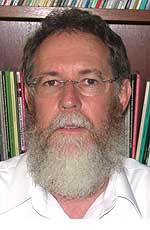Western Australia
February 20, 2008
 |
|
White rust
affecting a flower head causing distortion and
development of a ‘staghead’ formation instead of
seed production. |
|
 |
|
White rust, caused
by the microscopic fungus Albugo candida, on a
leaf. |
|
Researchers from the School of
Plant Biology at The University
of Western Australia (UWA) and
Department of Agriculture
and Food, Western Australia (DAFWA) have identified useful
sources of resistance to white rust in Brassica juncea mustard
germplasm sourced from Australia, China and India.
White rust affects cruciferous plants, which include the cabbage
family, and the infection can be local, appearing as white
pustules on leaves, stems and floral parts, or systemic, as
abnormal distorted growth of stems, pods and flowers, which is
commonly referred to as stagheads. Flowers displaying staghead
formation are sterile.
Caused by the microscopic parasite Albugo candida, white rust
significantly reduces yield in oilseed Brassicas, such as B.
juncea and B. rapa.
Combined infection of leaves and flowers under conducive
conditions for disease development can cause estimated yield
losses of up to 20 per cent in Australia and up to 60 per cent
or more in India.
 Member
of a research team funded through an Australian Centre for
International Agricultural Research (ACIAR) and Grains Research
and Development Corporation (GRDC) project, Associate Professor
Martin Barbetti (photo) of UWA and DAFWA, said the area sown to
B. juncea in Australia was set to rapidly increase since the
first canola quality mustard (B. juncea) cultivar, ‘Dune’, was
released in 2007. Member
of a research team funded through an Australian Centre for
International Agricultural Research (ACIAR) and Grains Research
and Development Corporation (GRDC) project, Associate Professor
Martin Barbetti (photo) of UWA and DAFWA, said the area sown to
B. juncea in Australia was set to rapidly increase since the
first canola quality mustard (B. juncea) cultivar, ‘Dune’, was
released in 2007.
“Such promising mustard cultivars will be of particular value to
farmers in lower rainfall areas because of its drought tolerance
and superior adaptation, it can be direct harvested and it
provides a reliable and profitable break crop,” he said.
However, Associate Professor Barbetti indicated that researchers
recognise the need to identify and exploit genes which confer
host resistance – a more cost-effective and sustainable control
than chemical or cultural means – and a pre-requisite for
managing the disease across all three countries.
Forty four genotypes of B. juncea, including 12 from Australia,
10 from China and 22 from India were screened for resistance to
white rust under WA field conditions by Dr Caixia Li of UWA.
The seed was obtained through a collaborative ACIAR and GRDC
funded project between Australia, China and India.
“Overall, the genotypes from China showed the best resistance,
followed by those from Australia, with those from India being
most susceptible,” Dr Li said.
The research identified genotypes highly resistant to strains of
A. candida in WA and a much faster, cheaper method of screening
seedlings under controlled environment conditions.
This is the first time very high levels of resistance or a
reliable method of rapid characterisation of genotype responses
to A. candida has been made available to Australian mustard
breeders.
Genotypes highly resistant to white rust will be used in the
mustard breeding program and, if they have appropriate agronomic
adaptation, could be deployed as new cultivars to manage white
rust in the most disease-prone areas. |
|